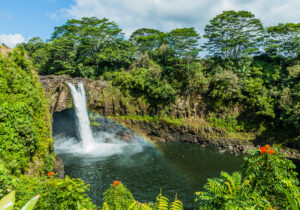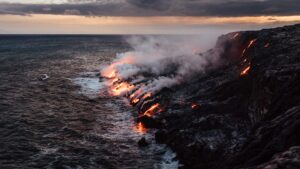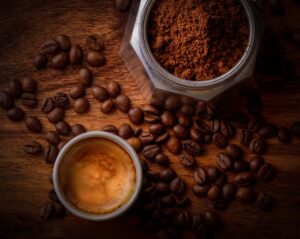Only In Your State lists 13 beautiful spots in Hawaiʻi. Our Wild and Scenic Volcano luxury tour experience highlights the lush side of the Big Island.
The Hawaiʻian Islands are known for their incredible beaches of all colors and sweeping vistas of lush jungles, vibrant greenery and the vast Pacific Ocean. There are other views, however, that are less common, and often not associated with our beautiful islands. From redwood forests and swamp trails to barren deserts and lava flows, here are 13 incredible spots you might be surprised to find in Hawaiʻi.
Redwood Forest
Located approximately 7,000 feet above sea level in Polipoli State Park is this forest is populated by redwood trees that were brought to Hawaiʻi in the 1920s to re-establish the watershed. The popular Redwood Trail is 1.7 miles, and guides hikers through a forest of baby Redwood trees, and is the access point for many other trails.
Alakai Swamp Trail
Located approximately 7,000 feet above sea level in Polipoli State Park is this forest is populated by redwood trees that were brought to Hawaiʻi in the 1920s to re-establish the watershed. The popular Redwood Trail is 1.7 miles, and guides hikers through a forest of baby Redwood trees, and is the access point for many other trails.
Lake Waiau
Located at 13,000 feet above sea level on the Big Island’s Mauna Kea, Lake Waiau is arguably one of the highest lakes in all of the United States. The lake relatively small, measuring in at just about 100 meters across, and seems out of place amongst the popularized images of Hawaiʻi.
Haleakala National Park
Just 27 square miles short of equaling the entire size of Oahu, Mount Haleakala is a gentle giant – a dormant volcano that has inspired those who make the journey to its summit for centuries. Translating to “House of the Sun,” Haleakala rises more than 10,000 feet above sea level, comprises 75 percent of Maui Island, and is home to desert-like conditions, rainforests, and everything in between.
St. Benedict Roman Catholic Church
Known more commonly as the Painted Church, this magnificent piece of art doesn’t feel as though it is in Hawaiʻi. The masterpiece was built from 1899 to 1902 under the direction of Catholic missionary Father John Velghe, an untrained folk artist who painted frescoes along the interior ceiling and walls depicting various biblical scenes.
Russian Fort Elizabeth
Just south of Waimea, on Kauai, is the last remaining Russian fort in Hawaiʻi. Built in the early 19th century as a result of an alliance between the High Chief Kaumuali’i and the Russian-American Company. The “treaty” granted Russian Tsar Alexander I a protectorate over Kauai, with the implication that Russia could capture the entire island chain from Kamehameha if desired. It is said that Kaumuali’i never intended to give up his power, but that the Russians would help him reclaim his own kingdom.
The Makawao Forest
The gorgeous Makawao Forest offers some incredible hiking on the Kahakapao Trail where you will see wild Koa, young Redwood trees, Rasberry bushes, Eucalyptus varieties, and fragrant Ginger plants. Located in upcountry Maui at a high elevation, the forest is a little colder than most of the island, bringing a welcome refuge from Hawaiʻi’s typical weather.
Koko Crater Botanical Garden
Cacti and Hawaiʻi aren’t necessarily synonymous, are they? A 60-acre garden within the Koko Crater, this botanical garden is also known as the Charles M. Wills Cactus Garden – a name that suits the hot, dry climate and the flora that are able to thrive in this environment. Oh, and this terrifying plant is an octopus cactus, in case you were curious.
Waimea Canyon
While Waimea Canyon is one of Hawaiʻi’s most famous landmarks, it doesn’t necessarily look as though it belongs. Often referred to as the “Grand Canyon of the Pacific,” Waimea Canyon is certainly a thing of immense beauty. At ten miles long, a mile wide and approximately 3,600 feet deep, it is home to plants and trees of all shapes and sizes – giving it a more dynamic landscape than its more famous canyon cousin.
Iolani Palace
We don’t often think of Hawaiʻi when we think of castles, but it’s hard to find a man-made wonder as enchanting as Hawaiʻi’s Iolani Palace, the royal residence for the Kingdom of Hawaiʻi from 1845 to 1893. After the monarchy was overthrown, the building served as the capitol building until 1969, and then in 1978, restored and opened as a museum. The palace features a unique style of architecture known as American Florentine, and is the only official state royal residence on United States soil.
Nu’uanu Resevoir
Near the Pali Highway and seen on a hike up to Lulumahu Falls, the Nu’uanu Reservoir is surrounded by a bamboo forest, jungle, and gorgeous field that feels as though it is a still taken straight out of the Sound of Music.
Mauna Kea
No one really expects to see snow when they visit Hawaiʻi, do they? Mauna Kea measures in at 13,796 feet above sea level, the highest point in the state of Hawaiʻi. In fact, when measured from its oceanic base deep in the vast Pacific, the mountain measures in at more than 33,000 feet tall – that’s higher than Mount Everest!
Mauna Ulu Lava Flow
Within Hawaiʻi Volcanoes National Park is the Mauna Ulu Lava Flow, a landscape that feels worlds away from the Hawaiʻian landscape photographed for postcards.




